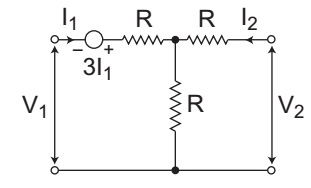-
The circuit shown in the figure above—

-
- is reciprocal but not symmetrical
- is not reciprocal but symmetrical
- is both reciprocal and symmetrical
- is neither reciprocal nor symmetrical
- is reciprocal but not symmetrical
Correct Option: A
The given circuit: 
Applying KVL in the input side, we get
V1 + 3I1 + I1R + (I1 + I2) R = 0
or
V1 = I1 (2R – 3) + I2R . . .. .…(i)
Again applying KVL in the output side
V2 = I2R + (I1 + I2)R
or
V2 = I1R + I2.2R …. . . . .(ii)
From equation (i) and (ii)
Z11 = 2R – 3, Z12 = R
Z21 = R, Z22 = 2R
● For the network to be symmetric
Z11 = Z22 (But here Z11 = 2R – 3 and Z22 = 2R)
So, network is not symmetric.
● For the network to be reciprocal:
Z12 = Z21 (Here Z12 = Z21 = R)
So, network is reciprocal.
Thus, we conclude that the given network is reciprocal but not symmetric.

